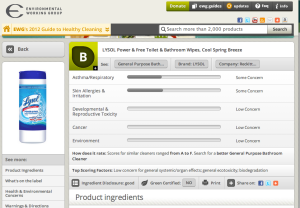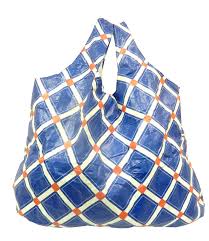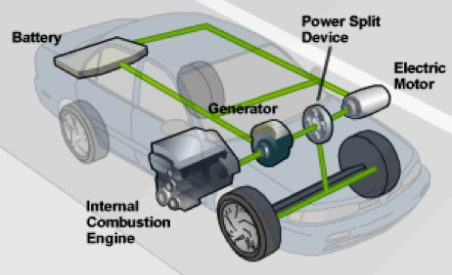Consumers are starting to become more and more concerned about their moral practices and purchases, especially when it comes to makeup, nail polish, and other cosmetic goods that are not considered absolute necessities in life. So if we are choosing to buy and use these products, we might as well choose the best ones for our environment, and ourselves, right? Issues like animal testing, toxic ingredients, sustainable practices, and more, are all reflected upon in the business of green cosmetics.

This diagram discusses the number of chemicals in all of the products used on the displayed model. It also notes the most dangerous chemicals and the possible side effects. It goes to show just how many chemicals are in the multitude of products that humans use on a daily basis.
According to this article on earth911.com, the average woman applies 515 chemicals in her daily “grooming” routine. A major chemical to watch for in conventional cosmetic products are PPCPs, which are toxic ingredients within pharmaceuticals and personal care products. The EPA states that PPCPs are
Pharmaceuticals and Personal Care Products as Pollutants (PPCPs) refers, in general, to any product used by individuals for personal health or cosmetic reasons or used by agribusiness to enhance growth or health of livestock. PPCPs comprise a diverse collection of thousands of chemical substances, including prescription and over-the-counter therapeutic drugs, veterinary drugs, fragrances, lotions, and cosmetics.
Sources of PPCPs are human activity like bathing, swimming, etc, illegal drug use, veterinary drug use, agribusiness, and pharmaceutical manufacturing. The environmental hazards they cause to the environment involve medication residues passing through the body and into the sewer lines, as well as medications placed in the trash that then infiltrate landfills. PPCPs are present in the nation’s water bodies, and cause ecological harm and disruption to aquatic endocrine systems. Review this detailed diagram about how PPCPs infiltrate our environment. The following picture diagram is titled “Origins and Fate of PPCPs in the Environment”, provided by the EPA.

(Click this link to see a zoomed in version of this diagram). It gives a detailed “story” of how PPCPs travel through the environment.
Other chemicals typically used in conventional cosmetic goods include parabens and petrochemicals. Parabens are preservatives that mimic estrogen and have been linked to cause cancer. Petrochemicals are ingredients derived from petroleum and are used as synthetic dyes.
Also, conventional products have a lot of high brow claims to do miracles to your appearance that defy the natural process of aging.
Lots of the high-tech, new generation cosmetics and beauty ‘wonder’ treatments naturally contain more chemicals to be able to achieve even better results, which, of course, means that women now carry more chemicals than ever before.
(this link)
These beauty tricks and “wonder treatments” do not come easily, and require many chemicals and harmful products to be achieved.
Nail polish, another traditional cosmetic product has a lot of harmful ingredients in conventional brands. It is a product that you put on your fingers, which are limbs that are used in so many different ways. Notably, for eating, which means that a lot of humans ingest this nasty stuff on nail polish. Watch out for the “Big 3”: dibutyl phthalate, tolune (developmental toxins), and formaldehyde (carcinogen used to preserve animals for dissection, etc) in nail polish. The three most common and harmful toxins used to create the product. Alternatives to conventional nail polish include non-toxic and more “natural formulas” which are starting to become more widely sold in typical drug stores, but can be found in many specialty stores like Whole Foods. Also, different manicuring practices like gel and Shelac manicures utilize techniques that prevent nails from chipping, thus humans from ingesting the polish. However, the process utilizes direct UV rays to dry the polish, which could lead to skin cancer. Check out this article from the nypost.com about the negative sides of such manicure practices.
Stores that carry green cosmetics look for diverse products that are deemed often certifiably organic, claimed to be all natural, fare trade, sustainable, etc. David Moore, the Whole Body Buyer and Merchandiser for Whole Foods stated, “We look for products from around the world. Certified organic and fair trade are equally important…”
“According to a 2005 survey of 2,300 adults by the Environmental Working Group, the average woman encounters 168 chemical ingredients in her beauty regimen everyday. And let’s not forget about the men — they’re slathering themselves with an average of 85 chemicals everyday, too.”
The EWG has a database called Skin Deep Cosmetics Database that compares cosmetic goods, similar to the database I incorporated in my review on cleaning goods (click here to view that post, and here to view the cleaning supplies database). This cosmetics database rates products in regards to their environmental benefits, or lack there of, just the same as the cleaning database. They review products, conventional and green in the categories of sun, makeup, skin care, hair, nails, fragrance, oral care, and more. They review the ingredient concerns in regards to overall hazard, cancer, developmental and reproductive toxicity, allergies and immunotoxicity, and use restrictions.
According to this article from treehugger.com:
- “33 percent: Personal care products that contain at least one chemical linked to cancer, according to the Skin Deep report by the Environmental Working Group, a partner of the Campaign for Safe Cosmetics.
- “77 percent: Percentage of rinse-off cosmetics that contain parabens; the figure rises to 99 percent for leave-on cosmetics such as sunscreens.”
These facts allow one to see the true benefits of using green cosmetics. They prevent exposure to disease causing ingredients, and thus improve the quality of their user’s life.
There are downsides however. These negatives allow you to reflect upon the positives of conventional cosmetics. Most green makeup products do not use synthetic dyes and colorants, this means that there is only a limited selection of hues, and thus not all skin tones and use such products. In order to apply correctly, these goods may require a specialized set of supplies (brushes, sponges, wands, etc).
Many of these products lack preservatives; therefore they expire quickly in the package, and do not always last very long on your face and/or body. Also, just because green products are often along the lines of natural and organic, it does not necessarily mean it is gentle or safe, and overall better for all skin types. Sensitive skin types can have adverse reactions to natural ingredients like essential oils.
The prices of green cosmetics, like most other green products are typically higher than that of the conventional alternative. The effort it takes to find the ingredients, and make them usable and appealing without harmful additives, toxins, etc, is quite the task. Also, packaging these materials in recyclable boxes or with sustainable practices, is more costly than the typical packaging practices.
Similarly to my post on green cleaning products, it is also hard for people to change their habits, as well as ignore societal norms. This is extremely prevalent in the beauty world, therefore green cosmetics are not what people always gravitate towards. In a world of people trying to constantly look younger, thinner, tighter, brighter, etc, they tend to buy whatever products they feel will make them look their personal best, and disregard the harmful consequences. Most green products do not contain face slimming, wrinkle smoothing, spot clearing technologies that many conventional beauty products have. So it is a question of what you want in a product in regards to health and in regards to aesthetics. Often there is overlap between those two criteria, but sometimes they just are not conducive.
So for a person like me, a darker skinned girl with some typical adolescent blemishes and marks on my skin, I may not gravitate towards the green product offerings in regards to makeup and hair, as apposed to other cosmetics. I see the value in such products, and want to preserve my health, as well as the environments in the best way possible. However, I cannot walk around looking odd with a lighter toned foundation applied to my face, just to avoid PCCPs or parabens on my skin. Therefore, my option would be to use conventional makeup or just no makeup at all (I usually choose the latter). I know I am not the only person who struggles with such choices. It is a shame that the environmentally friendly cosmetic options are not as accessible to everyone compared to their conventional alternatives. The average woman inadvertently consumes around five pounds of lipstick in her lifetime, so the things that we put on our mouth, face, hands, and body really should not be toxic and/or life threatening. If you meet the demographic of green makeup, hair, etc, and are interested in using them for you health’s sake as well as the environment’s, I would say go for it!!! I will try to best to utilize the green cosmetic options whenever I can. This depends on price of the product, who the product’s market is, and convenience. Like nail polish for instance, I am wearing the Seattle based nail polish brand: butter London’s “3 Free Nail Lacquer-Vernis” as I type! The back of the bottle states “3 Free Nail Lacquer ™ by butter London The High Price of Beauty? We don’t think so. Butter London is a 3 Free company. No Formaldehyde. No Toluene. No DBP Colour,not Carcinogens.” (The shade “Chimney Sweep” if you’re interested in seeing the color!!) Although I will say, this nail polish did set me back a wopping $15, when the drugstore brand may cost me $5. In sum, I support most efforts to help the health of the environment, and in that category, humans exist. Thus, the usage of green cosmetics is quite beneficial since their benefits generally focus on human health, but also have many valuable environmental elements too.
Bibliography:
Mazzoni, Mary. “Replace Your Cosmetics with These Eco-Friendly Alternatives.”Earth911.com. N.p., 27 Mar. 2013. Web. 17 Nov. 2013. <http://earth911.com/news/2013/03/27/eco-friendly-cosmetics/>.
Origins and Fate of PPCPs in the Environment. Digital image. Environmental Protection Agency. Epa.gov, Mar. 2006. Web. 17 Nov. 2013. <http://www.epa.gov/ppcp/faq.html>.
“Pharmaceuticals and Personal Care Products (PPCPs).” EPA.gov. Environmental Protection Agency, n.d. Web. 17 Nov. 2013. <http://www.epa.gov/ppcp/faq.html>.
Casciato, Paul. “Average UK Woman Wears 515 Chemicals a Day.” Reuters.com. Ed. Steve Addison. N.p., 19 Nov. 2009. Web. 17 Nov. 2013. <http://www.reuters.com/article/2009/11/19/us-britain-cosmetics-idUSTRE5AI3M820091119>.
Jerven, Taraneh G. “Top Picks for Eco-friendly Cosmetics.” Bcliving.ca. BC Living, n.d. Web. 17 Nov. 2013. <http://www.bcliving.ca/style/top-picks-for-eco-friendly-cosmetics>.
Davis, Sammy. “The 8 Commandments of Natural Beauty.” The Daily Green. Goodhousekeeping.com, n.d. Web. 17 Nov. 2013. <http://www.thedailygreen.com/living-green/natural-beauty-cosmetics/natural-beauty-tips>.
“How to Go Green: Women’s Personal Care.” TreeHugger. N.p., 25 Jan. 2007. Web. 17 Nov. 2013. <http://www.treehugger.com/htgg/how-to-go-green-womens-personal-care.html>.
“Women If You Use Conventional Makeup Heres the 515 Chemicals You’re Putting on Your Sweet Self Every Day.” Elephantjournal.com. Elephant Journal, 7 July 2012. Web. 17 Nov. 2013. <http://www.elephantjournal.com/2012/07/women-if-you-use-conventional-make-up-heres-the-515-chemicals-youre-putting-on-your-sweet-self-every-day/>.






























